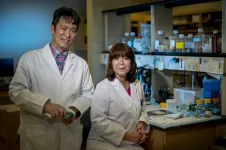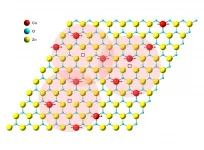(Press-News.org) Imagine you're a CEO who wants to promote an innovative new product -- a time management app or a fitness program. Should you send the product to Kim Kardashian in the hope that she'll love it and spread the word to her legions of Instagram followers? The answer would be 'yes' if successfully transmitting new ideas or behavior patterns was as simple as showing them to as many people as possible.
However, a forthcoming study in the journal Nature Communications finds that as prominent and revered as social influencers seem to be, in fact, they are unlikely to change a person's behavior by example -- and might actually be detrimental to the cause.
Why?
"When social influencers present ideas that are dissonant with their followers' worldviews -- say, for example, that vaccination is safe and effective -- they can unintentionally antagonize the people they are seeking to persuade because people typically only follow influencers whose ideas confirm their beliefs about the world," says Damon Centola, Elihu Katz Professor of Communication, Sociology, and Engineering at Penn, and senior author on the paper.
So what strategy do we take if we want to use an online or real world neighborhood network to 'plant' a new idea? Is there anyone in a social network who is effective at transmitting new beliefs? The new study delivers a surprising answer: yes, and it's the people you'd least expect to have any pull. To stimulate a shift in thinking, target small groups of people in the "outer edge" or fringe of a network.
Centola and Douglas Guilbeault, Ph.D., a recent Annenberg graduate, studied over 400 public health networks to discover which people could spread new ideas and behaviors most effectively. They tested every possible person in every network to determine who would be most effective for spreading everything from celebrity gossip to vaccine acceptance.
"Dozens of algorithms that are currently used by enterprises seeking to spread new ideas are based on the fallacy that everything spreads virally," says Centola. "But this study shows that the ability for information to pass through a social network depends on what type of information it is."
So, if you want to spread gossip -- easily digestible, uncontroversial bits of information -- go ahead and tap an influencer. But if you want to transmit new ways of thinking that challenge an existing set of beliefs, seek out hidden locations in the periphery and plant the seed there.
"Our big discovery," Centola added, "is that every network has a hidden social cluster in the outer edges that is perfectly poised to increase the spread of a new idea by several hundred percent. These social clusters are ground zero for triggering tipping points in society."
Centola and Guilbeault applied their findings to predicting the spread of a new microfinance program across dozens of communities in India. By considering what was being spread through the networks, they were able to predict where it should originate from, and whether it would spread to the rest of the population. Their predictions identified the exact people who were most influential for increasing the adoption of the new program.
Guilbeault, now an assistant professor at the University of California, Berkeley, noted, "in a sense, we found that the center of the network changed depending on what was spreading. The more uncertain people were about a new idea, the more that social influence moved to the people who only had parochial connections, rather than people with many far-reaching social connections." Guilbeault added, "the people in the edges of the network suddenly had the greatest influence across the entire community."
The findings "turn our notions about social influence for marketing, sales, and social movements upside down," says Centola. "Not everything spreads through a network in the same way," he adds, "and we can use this knowledge to pinpoint hotspots in the social graph. This can allow us to accurately tailor our network strategies for effecting positive social change."
Centola is the author of the new book, Change: How to Make Big Things Happen (Little Brown, 2021).
INFORMATION:
A new scoping review found that those with chronic health concerns, such as diabetes, heart disease, cancer, and autoimmune conditions, are not only at a higher risk of severe COVID-19 infection, they are also more likely to experience anxiety, depression or substance use during the COVID-19 pandemic.
The aim of the review was to address knowledge gaps related to the prevention and management of mental health responses among those with chronic conditions. The findings, recently published in the International Journal of Environmental Research and Public Health, were based on a comprehensive review of 67 Chinese and English-language studies.
"Levels ...
A recent study in Frontiers in Sustainable Food Systems shows that the fruits of a type of tomato plant send electrical signals to the rest of the plant when they are infested by caterpillars. Plants have a multitude of chemical and hormonal signaling pathways, which are generally transmitted through the sap (the nutrient-rich water that moves through the plant). In the case of fruits, nutrients flow exclusively to the fruit and there has been little research into whether there is any communication in the opposite direction--i.e. from fruit to plant.
"We usually forget that a plant's fruits are living and semiautonomous parts of their mother-plants, far ...
ANN ARBOR, Mich. - As children made fewer visits to health facilities and engaged in social distancing and other COVID-19 mitigation measures, a smaller number of them also received prescription drugs, a new study suggests.
Overall, medications prescribed for children dropped by more than a quarter during the first eight months of the pandemic compared to the previous year, with the steepest declines in infection-related medicines like antibiotics and cough-and-cold drugs.
Antibiotic dispensing to children and teens plunged by nearly 56 % ...
An internal transporter that enables us to use the copper we consume in foods like shellfish and nuts to enable a host of vital body functions also has the essential role of protecting the receptor that enables us to grow new blood vessels when ours become diseased, Medical College of Georgia scientists report.
The findings published in the journal END ...
The development of an ultrathin magnet that operates at room temperature could lead to new applications in computing and electronics - such as high-density, compact spintronic memory devices - and new tools for the study of quantum physics.
The ultrathin magnet, which was recently reported in the journal Nature Communications , could make big advances in next-gen memories, computing, spintronics, and quantum physics. It was discovered by scientists at the Department of Energy's Lawrence Berkeley National Laboratory (Berkeley Lab) and UC Berkeley.
"We're ...
Black holes with masses equivalent to millions of suns do put a brake on the birth of new stars, say astronomers. Using machine learning and three state of the art simulations to back up results from a large sky survey, the researchers resolve a 20-year long debate on the formation of stars. Joanna Piotrowska, a PhD student at the University of Cambridge, will present the new work today (Tuesday 20 July) at the virtual National Astronomy Meeting (NAM 2021).
Star formation in galaxies has long been a focal point of astronomy research. Decades of successful observations ...
The case of a patient who experienced two facial palsies - one after the first and another after the second dose of the Pfizer-BioNTech COVID-19 vaccine - strongly suggests that Bell's palsy (facial nerve palsy of unknown cause) is linked to the Pfizer-BioNTech vaccine, doctors write in the journal BMJ Case Reports.
They describe the first case to be reported in the medical literature of two separate unilateral facial nerve palsies, where muscles on one side of the face become weak or paralysed, occurring shortly after each dose of a COVID-19 vaccine.
"The ...
Although lockdowns are undoubtedly associated with health harms, their impact on health is unlikely to be worse than the impact of the COVID-19 pandemic itself, concludes a review published in the online journal BMJ Global Health.
During the COVID-19 pandemic, there has been an ongoing debate around whether the benefits of government "lockdowns"- either stay-at-home orders or interventions restricting movement - in reducing infections are outweighed by the negative impacts on the economy, social structure, education, and mental and physical health. In a nutshell, whether "the cure is worse than the disease."
In this narrative review, an international team of doctors examine the ...
One in eight children have mental disorders that cause symptoms and impairment and therefore require treatment, but even in high-income countries most of these children will not gain access to services to treat them, reports a study published in the journal Evidence-Based Mental Health.
Mental disorders that start in childhood and adolescence can significantly interfere with wellbeing and development.
Despite the social and economic implications of not addressing these disorders, including long-term healthcare costs, justice system costs and the loss of human potential, mental health service provision for children continues to lag behind provision of services for physical ...
Below please find summaries of new articles that will be published in the next issue of Annals of Internal Medicine. The summaries are not intended to substitute for the full articles as a source of information. This information is under strict embargo and by taking it into possession, media representatives are committing to the terms of the embargo not only on their own behalf, but also on behalf of the organization they represent.
1. Rapid screening, face masks may prevent SARS-CoV-2 transmission at indoor mass-gathering events
Abstract: https://www.acpjournals.org/doi/10.7326/M21-2278
URL goes live when the embargo lifts
An observational study in Barcelona, Spain found that implementation of same-day rapid screening, use of face masks, and improved ventilation was ...


